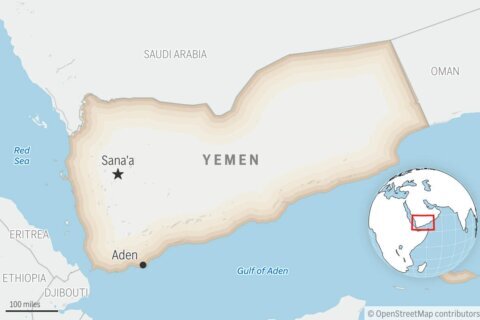TIJUANA, Mexico (AP) — The smells and sounds of Tijuana smack us as soon as we open the doors of our bug-splattered rental, a Jeep Renegade: food stalls selling roasted corn, churros and hot dogs; a near-empty bar blaring the oompa-oompas of norteno, Mexico’s answer to polka.
This is our last stop. We have just logged 3,000 miles from the Gulf of Mexico to the Pacific Ocean, crisscrossing back and forth across the world’s 10th-longest border 22 times over two weeks and blogging about the experience . We have traversed the terrain through which President Donald Trump would build a 30-foot-high wall; we have talked to anyone and everyone who was willing to open up to us.
We’ve seen a father and daughter speak through the bars of the border fence, and talked to an Arizona rancher who supports the wall but who has installed taps at every well on his desert property so migrants can drink. In Ciudad Juarez, we watched Mexican children throw rocks across the fence at railroad maintenance vehicles in the U.S. In Tijuana, we met a U.S. Army veteran who crossed the border, in her words, to “hide” from life for a few hours.
What we’ve found, from the near-empty migrant shelters of Tamaulipas state in Mexico to the drug-running corridors of the Sonoran desert, is a region convulsed by uncertainty and angst, but rooted in a shared culture and history unlikely to be transformed by any politician, or any barrier man can construct.
Border life “is not going to change,” said Ramon Alberto Orrantia, a 54-year-old restaurant parking attendant who has lived in Tijuana for 48 years. “People continue doing the same thing. Life is normal.”
___
Practically everyone we met has been welcoming and evinced a deeply held sense of the place they inhabit — from the Mexican-American sheriff in Nogales, Arizona, who shook hands through the fence and chatted amiably with a man he later said was probably a lookout for smugglers, to the cheery border agent in Deming, New Mexico, who astonished us with a thorough knowledge of the history of the AP’s founding during the Mexican-American War.
I’ve spent six years living and reporting along the border, most of it in the Rio Grande Valley of South Texas. My traveling companion, Rodrigo Abd, is an Argentine photographer who has covered some of the most violent conflicts on the planet but has spent little time on the border. He expected every American he met there to be fervently pro-Trump and pro-wall, but we often had a hard time finding such people.
Mostly, we found a culture that is neither exclusively Mexican nor American but distinctively both.
Nowhere was that more clear than in Columbus, New Mexico, and Palomas, Mexico, where each day about 1,200 children in backpacks and sneakers wake up in Mexico, cross the border and hop on school buses.
These kids are all American citizens; many of their parents were deported and moved to the frontier so they could get a U.S. education. They are the epitome of the bicultural border population, growing up fluent in both English and Spanish and prepared to thrive on either side.
“There are more opportunities there … more hours of work, and I think that all favors them,” said Ada Noema Gonzalez, whose 10-year-old son Jesus and 9-year-old daughter Karen live in Palomas and attend class at Columbus Elementary.
But life on the border is not always so hopeful. Drug trafficking and its accompanying violence are grave concerns. And Trump’s presidency has turned U.S.-Mexico relations on their ear with politicians exchanging insults, threats of possible trade wars, fears of mass deportations and near-constant talk of the wall.
All along the trip, people shared their very real concerns. Some feared the heavily armed cartel smugglers who mule cocaine shipments through their backyards in the dead of night. Others harbored less violent worries of losing a job or being separated from loved ones.
Fernie Velasco in Sunland Park, New Mexico, was grilling a mountain of steak next to his trailer when Rodrigo asked to photograph his kids jumping on a trampoline. A U.S. citizen who works construction and spent more than a decade as a migrant farm worker, he worries that his Mexican wife could lose her work permit and be deported at any time, leaving him alone with the kids.
In northern Mexico, thousands of people eke out a living at the so-called maquiladora plants that boomed under the endangered North American Free Trade Agreement and crank out all sorts of goods for export to the United States, everything from shoes to toys to electronics.
But while these jobs are treasured, it’s not an easy life. Reynosa plant worker Jorge Santiago told us how maquiladora entry-level wages, while well above Mexico’s minimum wage, are barely enough to scrape by: “Here everyone makes it with overtime.”
___
U.S. Homeland Security Secretary John F. Kelly acknowledged this week that despite Trump’s frequent promises to put up a solid barrier the length of the border, “it is unlikely that we will build a wall from sea to shining sea.”
To travel the length of the border is to understand why.
Where the Rio Grande makes a long slow curve through the aptly named Big Bend National Park, we bore witness to how nature already dwarfs any man-made wall that could be built. Here, twin sheer cliff faces rise 1,500 feet above the water.
At the bottom of the canyon there’s a shallow river with no border agents on either side to prevent park visitors from wading across. “As far as we understand, we just crossed an international border,” David Finston, a retired math professor from Las Cruces, New Mexico, told us.
Just west of El Paso, workers were welding hundreds of steel panels into place in a stretch of see-through fencing that was planned before Trump’s election and replaces a shorter chain-link fence. (There are now about 650 miles of different kinds of fence along the border.)
Many residents on both sides say the current fence is not stopping border crossers. Every night, they lean ladders up against the barrier and climb over.
Randy Calderon, a 44-year-old retired U.S. Army military police officer and security specialist, doesn’t favor a solid wall — he thinks blowing sand could build up to where people could just walk over it — but he likes this see-through fence of parallel bars in tandem with sensors and boosted policing.
“It’s a visual deterrent … a slow-down, which gives the security guards on the inside a chance to respond,” he said.
In Arizona, Jim and Sue Chilton offered a different take on the wall.
Jim hides surveillance cameras all over the couple’s 50,000-acre ranch in Arivaca, about 80 miles southwest of Tucson, and showed us videos on his laptop of camouflaged smugglers carrying backpacks through the scrub brush. They walk with military precision, stepping on rocks and wearing carpet-soled slip-ons to avoid leaving tracks.
“Outrageous,” said Jim, who has encountered smugglers carrying AK-47s. He has a beef with people from far away who shrug off border security.
“They say, ‘Oh, it’s OK for all these people to walk through Jim Chilton’s ranch,'” he said. “I mean, they have no skin in the game.”
And yet he and his wife both have empathy for the migrants who risk death to cross the border. Some have died on the Chilton’s ranch, prompting them to install drinking taps.
“No one comments on the cost of not having effective protection of the border,” Sue Chilton said. “That cost includes all those dead people, the raped and mutilated, the otherwise abused and abandoned.”
___
As the sun goes down over the ocean off Tijuana, a lighthouse comes alive and its rotating beam slaps a border surveillance tower on U.S. soil. At a nearby bar, Mexican baseball fans are watching the San Diego Padres beat the Los Angeles Dodgers on four large-screen TVs.
The San Ysidro U.S. port of entry between Tijuana and San Diego is the busiest crossing in the Western Hemisphere, handling 50,000 northbound vehicles and 25,000 pedestrians each day — more people than the top two U.S. airports for international arrivals combined. They’re crossing to go to work or school; as tourists; to visit family, dine out and party; to shop for cheaper medicines in Mexico or flat-screen TVs in the United States — which, odds are, may very well have been assembled in Mexico in the first place.
The two countries do about $584 billion in commerce each year, with much of that crossing by land. People along the border are more likely to be bilingual and often share an affinity for things like baseball teams, jacked-up pickup trucks and chile-spiced cuisine. They draw water from the same rivers to drink and irrigate crops, and their governments work to protect the same ecosystems and imperiled species.
It’s a relationship that can be adversarial at times. Far more often, it’s symbiotic.
“We Mexicans have been through a lot, especially here in our own country,” said Hector Mendez Leon, a 28-year-old Mexican who was about to cross from Tijuana to his cashier’s job at a clothing store in Chula Vista, California. “So for Mexico, a president like (Trump) is like having a cold. . One day you will get over it.”
___
For more stories, photos and videos from Christopher Sherman and Rodrigo Abd, check out their Tales From the Border blog here: https://apnews.com/tag/TalesfromtheBorder
Copyright © 2025 The Associated Press. All rights reserved. This material may not be published, broadcast, written or redistributed.






